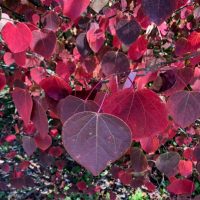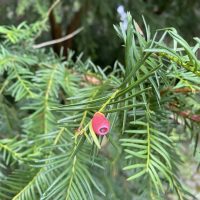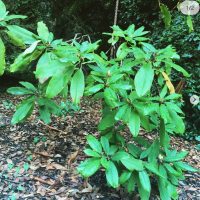February Plant Profile: Sycopsis sinensis

If you visit the grove of Sycopsis at the Pacific Connections Garden along Arboretum Drive this February you will be in for a treat – the flowers, while not showstoppers individually, are blooming in incredible quantity this winter.
Read moreNovember Plant Profile: Disanthus cercidifolius

Learn all about Disanthus cercidifolius, the redbud hazel – a show-stopping shrub for shady gardens that we have many examples of at the Washington Park Arboretum and the Center for Urban Horticulture.
Read morePlant Profile: Taxus brevifolia

Scientific Name: Taxus brevifolia
Common Name: Pacific yew, western yew
Family: Taxaceae
Native Range: Western coast of the United States, from southern Alaska to northern California; western Rocky Mountains, from northern British Columbia to Idaho and Montana
Location in the Arboretum: South end of the Arboretum above Azalea Way (Grid 17-1E)
The Pacific yew, Taxus brevifolia, is a native tree or large shrub that is often overlooked below the overstory of large iconic Pacific Northwest trees such as Western redcedars, Douglas firs, and Western hemlocks.
August Staff Profile: Ron Schmaltz

Meet our August Staff Feature – Ron Schmaltz! Ron is the horticulturalist in charge of one of the Washington Park Arboretum’s signature collections: Rhododendron Glen. Ron spent almost 30 years as an IT software developer before pivoting to horticulture. After returning to school at the Edmonds College, Ron started as an intern at the Arboretum in 2017 and, before too long, was working as an official gardener and caring for the 4 acres that make up the Glen.
Read moreAugust Plant Profile: Camellia sasanqua
Scientific Name: Camellia sasanqua
Common Name: sasanqua camellia; the Japanese name for all camellias is tsubaki,“tree with shining leaves,” while the Japanese name for Camellia sasanqua is sazanka, “plum-flowered tea.”
Family: Theaceae
Conservation Status: Least Concern
Native Range: Lowland forests of southern Japan
Culture/Habit: Organically rich, evenly moist, well-drained soils in shade to sun. Small trees to 16 feet tall or vining shrubs growing wider than tall, often depending on sun exposure.
July Plant Profile: European Beech
Scientific name: Fagus sylvatica
Common Name: Common beech, European beech
Family: Fagaceae (Oak family)
Conservation Status: Least Concern
Locations in the Washington Park Arboretum: Oak Collection area, directly east from the Graham Visitor Center
Fagus sylvatica, 3 specimens 595-44-A &B & 907-50-A: grids 42-1E, 43-1E
F.sylvatica ‘Aspleniifolia’ 1142-49-A: grid 41-1E
F.sylvatica ‘Dawyck’ 490-57-A: grid 40-1E
F.sylvatica ‘Riversii’ 682-67-A: grid 44-B
F.sylvatica ‘Rohanii’ 382-50-A: grid 42-1E
F.sylvatica ‘Spaethiana’ 654-54-A: grid 42-1E
F.sylvatica f.
March 2024 Plant Profile: Japanese Ornamental Cherry Tree Acquisitions
Scientific name: Prunus species
Various species:
P. Sato-zakura Group: Cultivars: ‘Shirotae’, ‘Shoetsu’, ‘Ukon’ ‘Chosho-Hizakura’, Sekiyama’
‘Ohochin’ ‘Oeshokun’
P. serrulata: Cultivars: ‘Asagi’ ‘Iohiyo’, ‘Shirofugen’, ‘Tai-Haku’, ‘Taoyome’ ‘Wase-Miyako’ ‘Horinji’
P. subhirtella: Cultivars: ‘Eureka Weeping’ ‘Pendula’ ‘Rosea’ ‘Stellata’ ‘Higan Weeping’ ‘Whitcomb’
P. sargentii: Cultivar: ‘Pink Flair’
Prunus x yedoensis: Cultivar: ‘Akebono’, ‘Shidare-yoshino’, ‘Somei-Yoshino’
P. x juddii
Common name: Japanese Ornamental Cherry
Family: Rosaceae
Native Range: Japan
In the Arboretum: Along Azalea Way
Issues: brown rot, cherry bark tortrix larvae, crown gall, root rot, low tolerance of compacted or wet soils
During spring’s first blossoms, I brag to anyone who will listen that the Japanese ornamental cherries at the Washington Park Arboretum are the most amazing display in the city and that they MUST go for a walk along Azalea Way to view this splendor.
Read moreFebruary Plant Profile: Wheel Tree

Scientific name: Trochodendron aralioides
Synonyms: Trochodendron longifolium
Common name: Wheel tree, parasol tree, birdlime tree, yamaguruma, nagaba-no-yamguruma, kun lan shu, ka-tang-lai
Family: Trochodendraceae
Native Range: Japan (south of Yamagata), Kyushu, Shikoku, Ryuku Islands, Taiwan
Height and Spread: May grow from 60-75 tall feet in the wild with trunks as large as 16 feet in diameter, typically 20-25 feet tall by 10-15 feet wide in cultivation.
October Plant Profile: Tree of Heaven
Scientific name: Ailanthus altissima
Common name: Tree of Heaven, Stinking Sumac, Paradise Tree
Family: Simaroubaceae
Native Range: Taiwan and China, hardy to USDA Zone 4
Habit: Grows between 60-90 feet tall and can grow to around 25 feet in a single year. The bark is smooth and tan to gray in early growth. With age, bark will become rugged with heart-shaped leaf scars.
